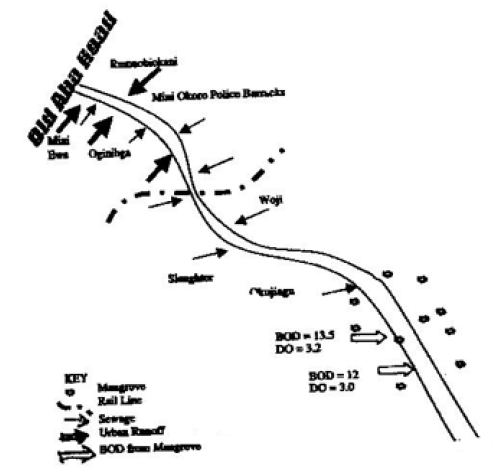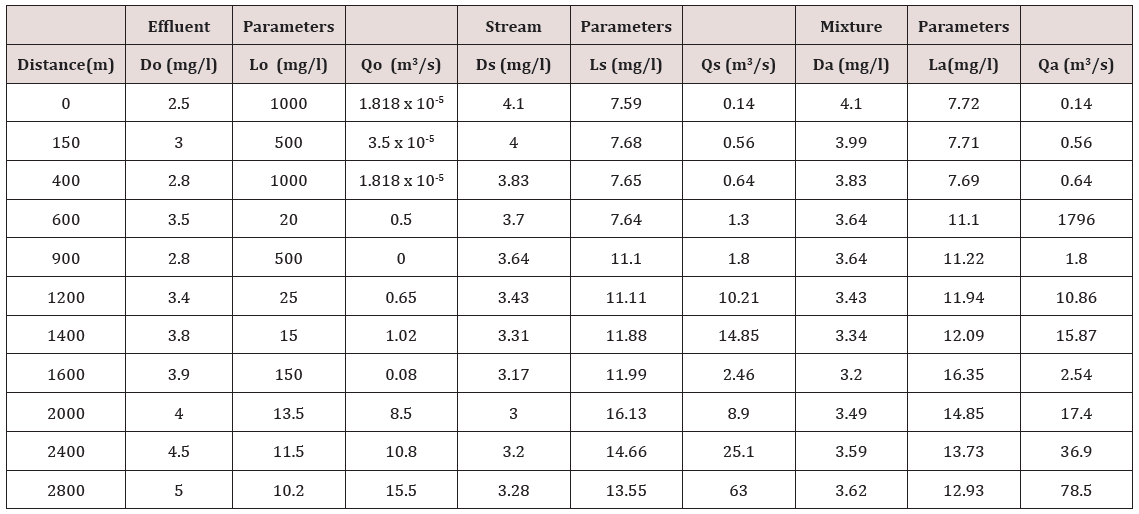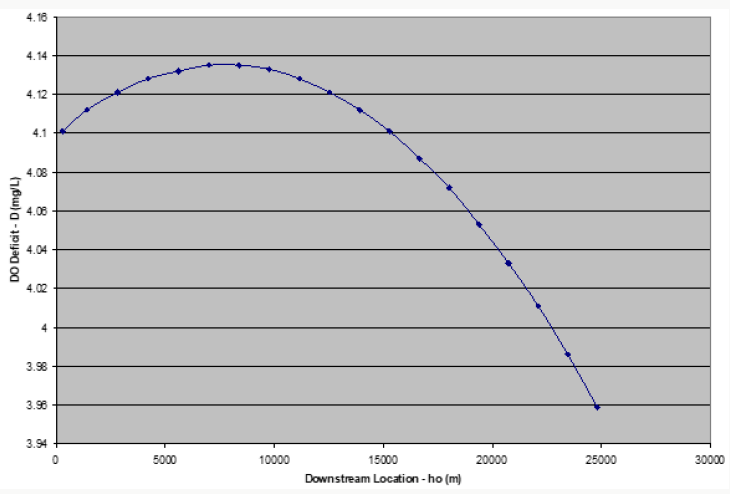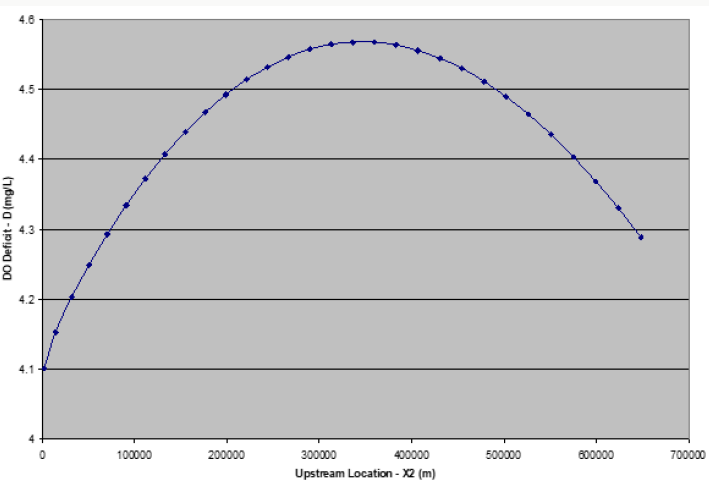Saturday, August 31, 2019
Lupine Publishers: Lupine Publishers | Forced Traction: An Error
Lupine Publishers: Lupine Publishers | Forced Traction: An Error: Lupine Publishers | Journal of Veterinary Science Introduction Immediate cause of dystocia requires certain preparations an...
Lupine Publishers| Optimization of Waste Discharge Points in Natural Streams
Lupine Publishers | Civil Engineering Research Journal
Abstract
For case2, the waste discharge locations are to be placed at optimal locations 40995.43m, 30665.17m, 41233.69m upstream and downstream waste discharge points respectively at an optimum DO deficit of 4.567mg/l. This means that if a new waste input is proposed for a stream its BOD input and its proposed location with respect to other inputs are important in order to determine the effect on the DO level in the stream Discharges from the second treatment plant would result in decreased dissolved oxygen level for a substantial distance downstream. This can have significant effects for streams and rivers with many influent waste streams over their course, as the dissolved oxygen (DO) will not have a chance to recover between each influent stream, resulting in significantly depressed oxygen levels .The dissolved oxygen (DO) deficit becomes zero at approximately the same distance downstream for both cases, though the two point source discharge case (case2) shows a higher short term DO deficit. This can cause problems if they DO concentration drops below the stipulated levels for the creek, leading to possible death of fish and other aquatic lives. It is therefore recommended that industrial establishments planning to site their treatment facilities along rivers or streams should be compelled to discharge their waste stream in compliance with the optimal locations with respect to any existing plant, so as to avoid undue dissolved oxygen (DO) depletion.
Keywords: Point Sources; Effluent; Discharge Point; Impact, Creek; Optimal Location; Sampling
Introduction
According to Yudianto et al. [11] the simplest manifestation of this equation is usually applied for a river reach characterized by plug flow system with constant hydrology and geometry under steady state condition, as occurred in Amadi creek. For a large river or estuary, considerable longitudinal dispersion influences the phenomenon of DO and BOD distribution and so the governing equations becomes a partial differential equation. However, the effect of dispersion on DO and BOD in small rivers, like Amadi Creek, used in this study, is negligible Li [12]. Water collected for sampling is discharged into Amadi creek without any treatment as point source. Therefore, specifically Amadi creek is modeled with single point source of BOD in this study. Much research has been done on the area of DO depletion in water bodies, providing information on critical deficit, critical distance, and minimum DO concentration, but none of these studies has attempted to optimize the waste discharge locations for minimum impact of oxygen demanding resources (BOD) on water quality. This would have enabled us to establish an optimum deficit and optimum discharge locations for minimum impact of oxygen demanding resources on water quality. Such a study has been undertaken in Amadi Creek. This research was therefore carried out to identify and quantify the amount of waste water effluent entering the creek and evaluate the impact of these oxygen demanding wastes on water quality. A novel approach that will help minimize stream pollution when there are many industries discharging waste water into a stream is presented. Also, the determination of points of maximum DO deficit in case of multiple discharges along a stream using classical optimization technique is discussed.
Brief Description of the Study Area
Methodology
Theoretical Formulation
Case 1 – One Source of Waste Water Discharge (Figure 2)The dissolved oxygen deficit along the reaches are:


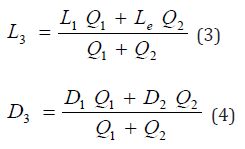
 which integrates
to;
which integrates
to;

The dissolved oxygen deficit along the reach CD, gives;



Substituting equations (7) and equation (8) into equation (6) gives:

a) The main assumption in the formulation of the equations is that the river reach is characterized by plug flow system with constant hydrology and geometry under steady state condition and is traveling at a constant speed (u).
b) It is also assumed that water temperature is constant throughout the stream. Mixing of different temperature streams is not accounted for.
c) It is assumed that there is a constant discharge of waste water into the creek and also that the waste water is discharged into Amadi creek without any treatment as point source. Therefore, specifically Amadi creek is modeled with single point source of BOD in this study.
Optimization Problem
The problem of searching for the optimal waste discharge locations, for minimum impact on water quality may be expressed (Figures 2 & 3) as;
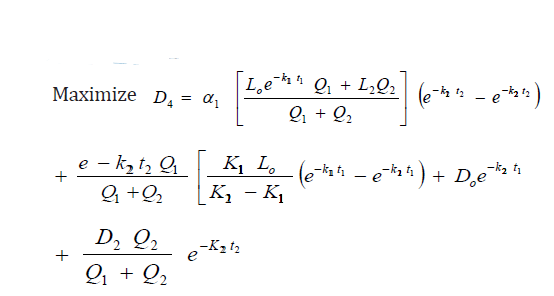
where, X1 and ho are the optimal waste discharge locations
Equations (5) and (6) represents the mathematical models for the stated problem. This is an optimization (maximization) problem Nwaigwe [13]. The desired solution of the above problem involves the search for the optimal values of the waste discharge locations i.e. the optimal determination of the values of x1 and ho for each waste discharge point. This can be solved by the method of simple calculus as follows;
Case 1: The derivative of equation (5) when
 is
is

The derivative of e. q (5) when
 is
is

Hence the optimal locations X1 and ho at which the waste discharge locations will be placed for minimum impact on water quality are obtained by solving equations (11) and (12) as;
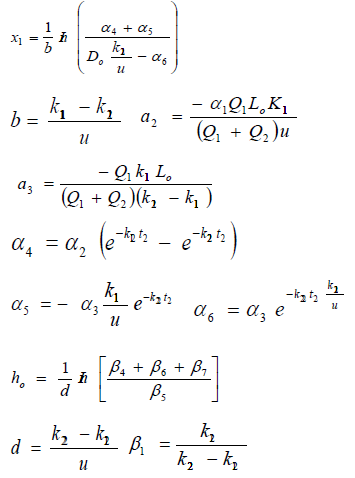
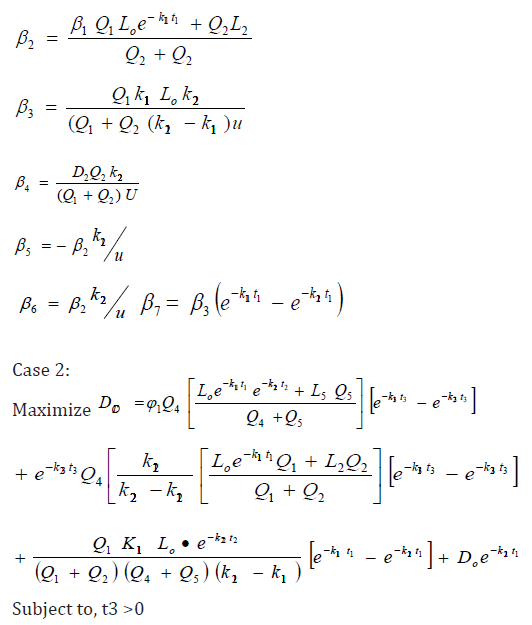
The derivative of e q (10) when

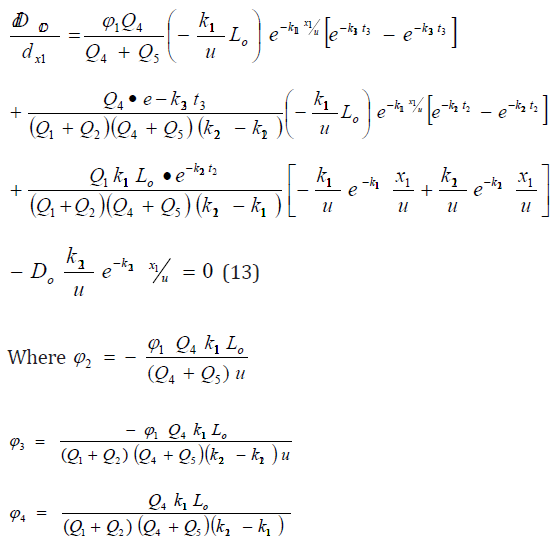


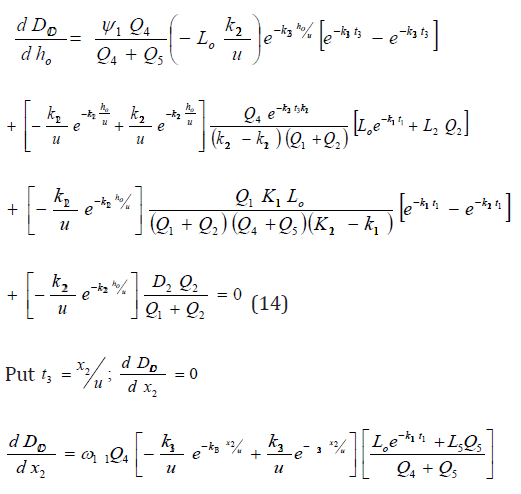

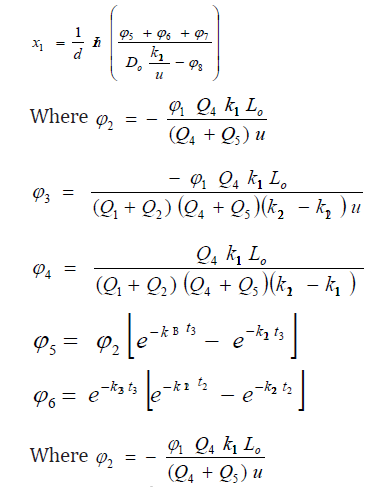

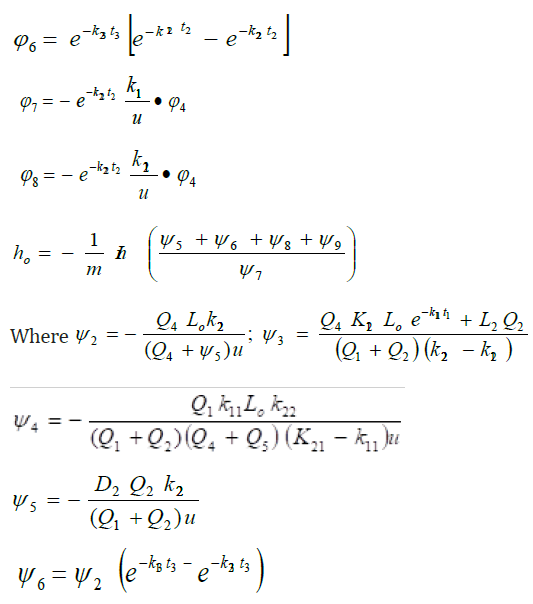
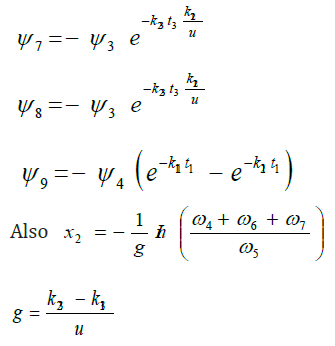
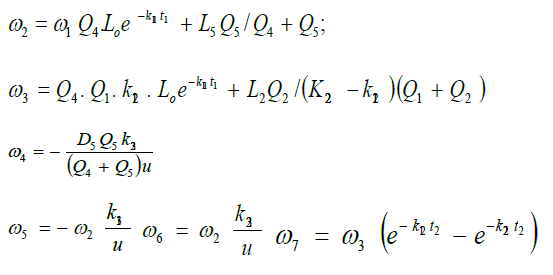
Application of Models
The developed models were applied to the water quality data for Amadi Creek (Table 1). The input data for simulations of the two case studies are;Case 1: Q1 = 0.139m3/s, Q2 = 0.5m3/s, Lo = 7.59 mg/l, Do = 4.1 mg/l
k11 = 0.1/day, k12 = 0.17/day, L2 = 20mg/l, k21 =0.17/day k22 = 0.23/day.
Case 2: Q5 = 0.65m3/s, L2 = 25 mg/l, D5 = 3.4 mg/l, k13 = 0.26/ day, k23 = 0.42/day
Substituting the above values in the above equations gives the optimal locations X1 and ho as10015.382m and 6992.282m respectively, at an optimum deficit of 4.135mg/l for case 1.Thus the model predicts that at an optimum deficit of 4.135mg/l the waste discharge locations would have to be placed at 10015.382m and 6992.282m upstream and downstream waste discharge locations respectively for minimum impact on water quality. For case 2, substituting these values in the above equations results in an optimum DO deficit of 4.567mg/l at optimal locations of 41233.43m, 40995.17m, 30665.69m upstream and downstream waste discharge locations respectively, to ensure minimum impact on water quality. The DO, BOD and temperature of the mixture effluent with creek water was obtained.
From

where Cm represents concentration of any parameter such as DO, BOD and water temperature at the point effluent mixes with creek water. The subscript denotes stream (or creek) and waste water respectively and Qs is the stream flow rate and Qw is the waste water flow rate. In order to convert BOD5 to ultimate BOD (Lo), using the first order decay rate, an extrapolation can be made according to Agunwamba et al. [2], as follows:

Effect of Flow conditions on Single Point Source Discharge
Effect of Flow Conditions on Two Sequential Point Source Discharge
Conclusions and Recommendations
For more Lupine Publishers Open Access Journals Please visit our website: http://www.lupinepublishers.com/
For more Civil Engineering Research Journal articles Please Click Here: https://lupinepublishers.com/civil-engineering-journal/
To Know More About Open Access Publishers Please Click on Lupine Publishers https://lupinepublishers.us/
Friday, August 30, 2019
Lupine Publishers: Change of Evaporations Leads to Climate Change
Lupine Publishers: Change of Evaporations Leads to Climate Change: Lupine Publishers- Environmental and Soil Science Short Communication The basis of all floods and droughts is water, its e...
Thursday, August 29, 2019
Lupine Publishers: Lupine Publishers | The Use of Epidural Anaesthesi...
Lupine Publishers: Lupine Publishers | The Use of Epidural Anaesthesi...: Lupine Publishers | The Journal of Veterinary Science Abstract General anaesthesia is an essential component of modern m...
Wednesday, August 28, 2019
Lupine Publishers: Change of Evaporations Leads to Climate Change
Lupine Publishers: Change of Evaporations Leads to Climate Change: Lupine Publishers- Environmental and Soil Science Short Communication The basis of all floods and droughts is water, its e...
Friday, August 23, 2019
Lupine Publishers: Lupine Publihsers | The Development Fortified Pan ...
Lupine Publishers: Lupine Publihsers | The Development Fortified Pan ...: Lupine Publishers | Journal of Veterinary Science Abstract The main objective of the research is to develop pan bread nutri...
Thursday, August 22, 2019
Lupine Publishers: Lupine Publishers | Use of Dietary Yeast and its P...
Lupine Publishers: Lupine Publishers | Use of Dietary Yeast and its P...: Lupine Publishers | Journal of Veterinary Science Abstract All around the world, sheeps and goats play an important role in...
Wednesday, August 21, 2019
Lupine Publishers: Optimization of Chitosan+Activated Carbon Nanocomp...
Lupine Publishers: Optimization of Chitosan+Activated Carbon Nanocomp...: Journal of Chemical Sciences | Lupine Publishers Abstract First, the minimum energy (geometry optimization DFT-DMol3) i...
Thursday, August 15, 2019
Lupine Publishers | Sustainability Practices for Urban Housing Societies
Lupine Publishers | Journal of Civil Engineering Research
Abstract
Keywords: Sustainability; Urban community; Reuse; Rainwater Harvesting; Composting; Electrical and electronic waste; Plastic
Introduction
Rainwater Harvesting
Grey-Water Gardening
Biodegradable Waste Composting
Abolishing Cellular Phone Tower
Electronic and Electrical Waste
Plastic Waste Management
Conclusion
Wednesday, August 14, 2019
Lupine Publishers | Discussion on Steel Fiber Reinforced Concretes (SFRC)
Lupine Publishers | Journal of Civil Engineering Research
Introduction
SFRCs are supposed to enhance the understanding of the material’s behaviour and will provide a basis for experimental research into the aspect of scatter in the post-cracking behaviour. It starts with the rheological properties of SFRC, since the workability can strongly influence several stages of the production process [3], and especially the strongest affect is seen on the post-cracking behavior of the composite material. The general tensile behavior of concrete is demonstrated in Figure 1 [4]. Without any fiber reinforcement, the plain concrete matrix exhibits a strain-softening response with low tensile strength and ductility. Because, due to low fracture toughness of concrete, tensile cracks may easily occur when there is an applied stress. The interfacial bond developed between the fibers and matrix makes use of the strength and stiffness of the fibers in reinforcing the brittle matrix. Once the matrix cracks, load can be still transferred across the crack faces through the steel fibers. As the load on the composite is increased, the process of fiber pullout affects load carrying capacity and further contributes to energy dissipation. It has also been known that when using a high volume fraction of fibers with a high specific surface area, the crack bridging potential and the strength of the composite are increased [5,6]. The flexural behavior of SFRC changes substantially compared to plain concrete. Depending on the amount and type of fibers used both the peak load and the ductility can be increased. Explanations will be presented for the fact that the flexural strength can be increased by virtue of fiber addition whereas this is hardly possible with regard to the compressive strength. In bending, the flexural load-bearing capacity can be increased even at low fiber volumes as long as the matrix strength. Fiber reinforced concrete has found interesting new applications in the past two decades due to its inherent superiority over normal plain and reinforced concrete in the following properties: higher flexural strength, better tensile strength and modulus of rupture, higher shear strength, higher shock resistance, better ductility and fatigue resistance, crack resistance and failure toughness [7]. Fiber-reinforced concrete has received its most increasing interest, especially with its presence in conventional concrete, improving certain mechanical properties of concrete. Different fiber types, fiber volume fractions and matrix compositions yield very different material behaviors. Even by changing the fiber content alone, the mechanical behavior of the concrete may change from being almost as brittle as plain concrete to even deflection-hardening materials.
In plain concrete, micro cracks develop even before loading, particularly due to drying shrinkage or other causes of volume change. The width of these initial cracks seldom exceeds a few microns. When loaded these micro cracks propagate and open up and due to stress concentration, additional micro cracks are formed. The micro cracks are the main cause for elastic deformation in concrete. Fiber reinforced cement and concrete were developed to overcome these problems. As a result of the incorporation of short discrete fibers cracks propagates into a slow controlled growth. This gives the cement-based materials maximum ductility overcoming its low tensile strength properties. The crack-bridging effect provided by fibers generates residual tensile strengths that improve both the durability and the toughness of concrete. It is the improvement of toughness and the crack distributing properties that motivate the use of fibers. This fact has been contributing to an increasing number of structural applications of SFRC [8]. The beneficial effects of fiber reinforcement are therefore twofold: not only are mechanical properties such as toughness and strength improved, but there are also new possibilities for optimization of materials for certain structures. Nonetheless, there is still a long way to go on the development of methods and design procedures to improve the reliability of this material.
For more Lupine Publishers Open Access Journals Please visit our website: http://www.lupinepublishers.com/
For more Journal of Civil Engineering Research articles Please Click Here: https://lupinepublishers.com/civil-engineering-journal/
To Know More About Open Access Publishers Please Click on Lupine Publishers: https://lupinepublishersgroup.com/
Friday, August 9, 2019
Lupine Publishers: Lupine Publishers | Anti-Synepthelichorial Placent...
Lupine Publishers: Lupine Publishers | Anti-Synepthelichorial Placent...: Lupine Publishers | Journal of Veterinary Science Hens were immunized with a macerate of goat and sheep placentomes. Immunizations w...
Subscribe to:
Posts (Atom)
Lupine Publishers| Informal sector housing Scenario Analysis for Chattogram, Bangladesh: A Way Forward
Abstract Population growth rate, urban migration and natural disasters are making, the chronic shortage of housing in the develop...

-
Improving Residential Buildings Performance against the Explosion Using Passive Defense RequirementsCase Study: Designing a Residential B...
-
Polyurea Coated and Plane Reinforced Concrete Panel Behavior under Blast Loading: Numerical Simulation to Experimental Results ( TCEIA )...
-
Abstract Population growth rate, urban migration and natural disasters are making, the chronic shortage of housing in the develop...
